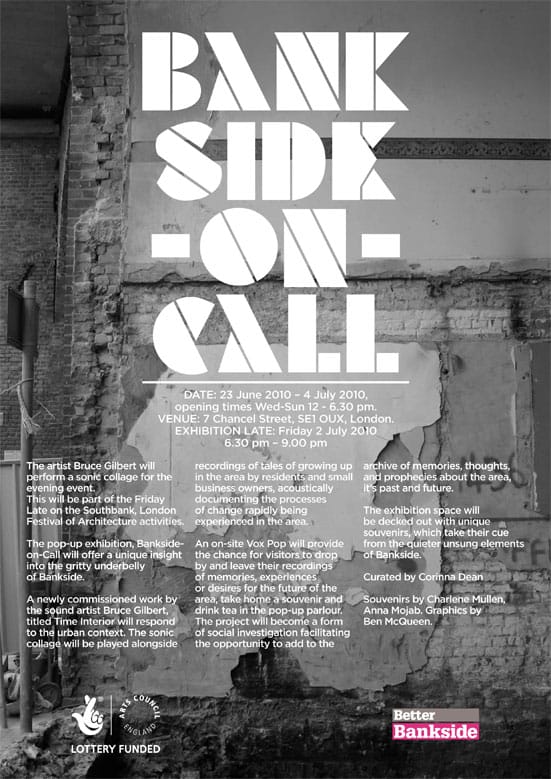23rd June 2010 — 4th July 2010
Opening times Wed-Sun 12 - 6.30 pm)
Venue: Railway Arch 7 Chancel Street, SE1, London, SE1 0UX
Exhibition launch, Friday 2nd July 2010 (6.30 pm – 9.00 pm)
The artist Bruce Gilbert will perform a piece for the evening event.
This will be part of the Friday Late on the Southbank, London Festival of Architecture activities.
The exhibition aims to provide a platform to investigate how regeneration in Bankside is affecting long and short-term residents and businesses. The installations explore the everyday narratives that often go unrecorded against the more dominant players that are influencing the physical environment, which is changing at an accelerated pace. Bankside-on-Call consists of a sound installation by the artist Bruce Gilbert, Time Interior which will interpret local sounds providing a context for the individual audio stations playing out interviews of local narratives recounting residents’ experiences and memories of growing up in Bankside and as well as comments on the accelerated pace of urbanism.
The exhibition acts as a hybrid of gallery, tearoom, consultation space and living room. The tea parlour houses a recording booth to create a live sound archive where visitors are invited to add to the oral history archive by leaving their comments, wishes, desires or memories about Bankside. The interviews tell a quieter narrative, a counterpoint to the physical expression of change. The project will become a form of social investigation facilitating the opportunity to add to the archive of memories, thoughts, and prophesies about the area, it’s past and future through the on-site Vox Pop.
The designer Charlene Mullen has responded to the details of the locality by reinterpreting an eighteenth century banqueting tablecloth and incorporating details from Terry’s Cafe on Great Southwark Street which celebrates great traditional British food. The alternative souvenirs take their cue from the surrounding context. Mullen’s Teacloths, portray an illustrative version of the changing skyline around Bankside; Waste Paper sculptures are casts of bottles washed up on the Thames shore at the foot of Tate Modern and the china range titled Fragile are made up of found pieces of crockery collected at low tide, pieced together to make fragile containers.
The accelerating pace of developments around the perimeter of Tate Modern counter the quieter areas to the south of Southwark Road. To explore these polarities of place, Gilbert has produced Time Interior (2010) a sonic collage that responds to the everyday space of Bankside, acoustically mapping the area from the Thames to the railway viaducts.
Gilbert, “My aim is to combine these voices and sounds to form not just a documentary backdrop but also a sonic collage. The material emanates from the past, present and possible future(s). The work aims to create from these elements a "timeless zone" where, though site specific, some kind of universal urban truth will leak into the consciousness of the visitor.
Bankside, previously named North Southwark was labelled with all types of negative terms: London’s underbelly, a den of iniquities; it acted as the counter point to London’s more reputable North side of the river. Escaping the city’s jurisdiction meant that prostitution, gambling and bearbaiting to name a few vices were rife. In the latter part of the nineteenth century the railway viaducts were built to create better connections in the city. Some say they created more damage than Second World War bombing, cutting up previously tight knit communities. The arches, without a doubt create a strong dominant feature in the urban landscape, majestic in their structure, they have housed the ‘oil’ trades, taxi repair ranks, cafes, as well as set designers and paper merchants, a throw off from the past. The railway viaducts have for some cocooned this area, for others created a barrier that prevents flow through the city. Bankside-on-Call is a small intervention, a pause amongst the cranes.
Curated by Corinna Dean
